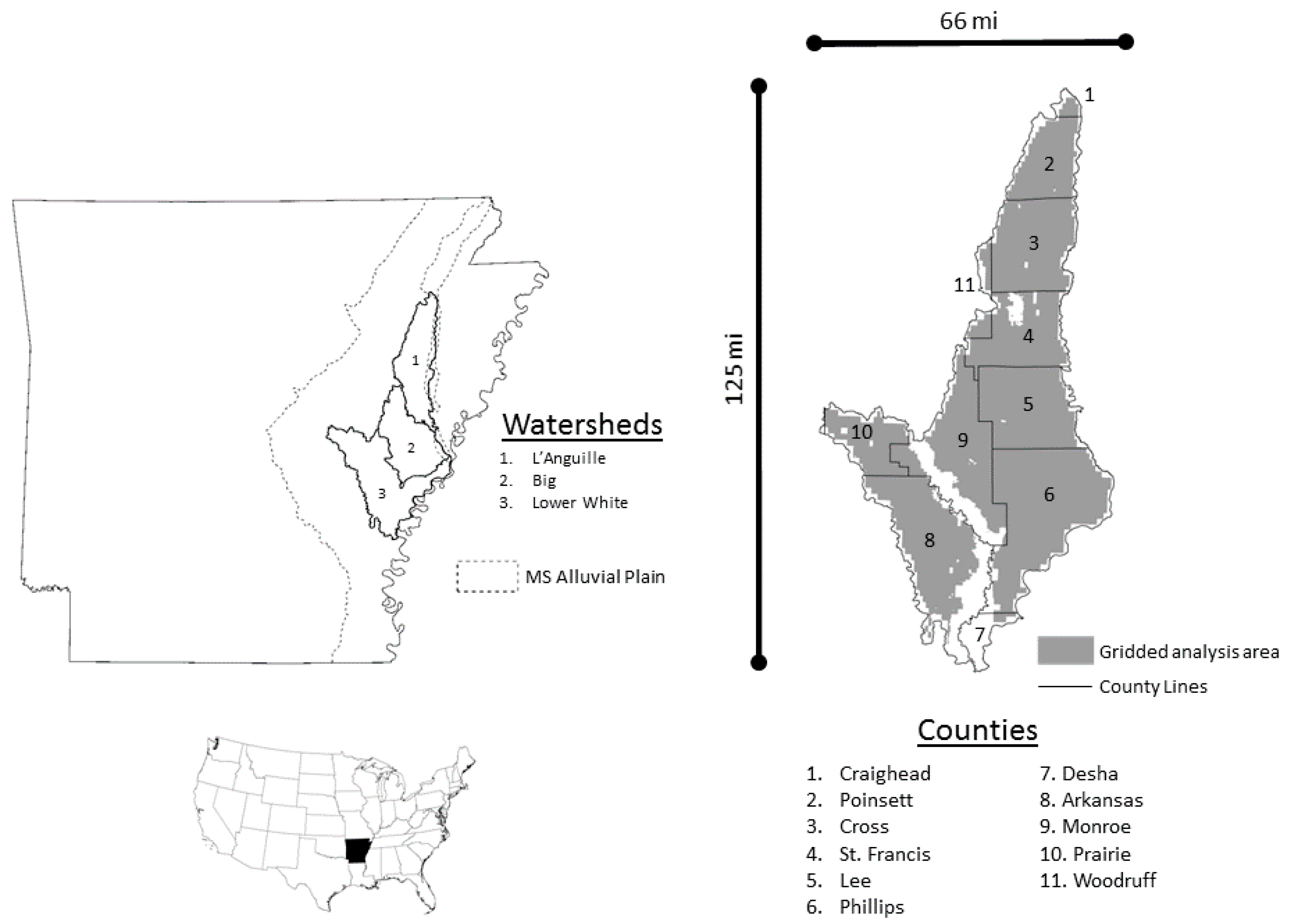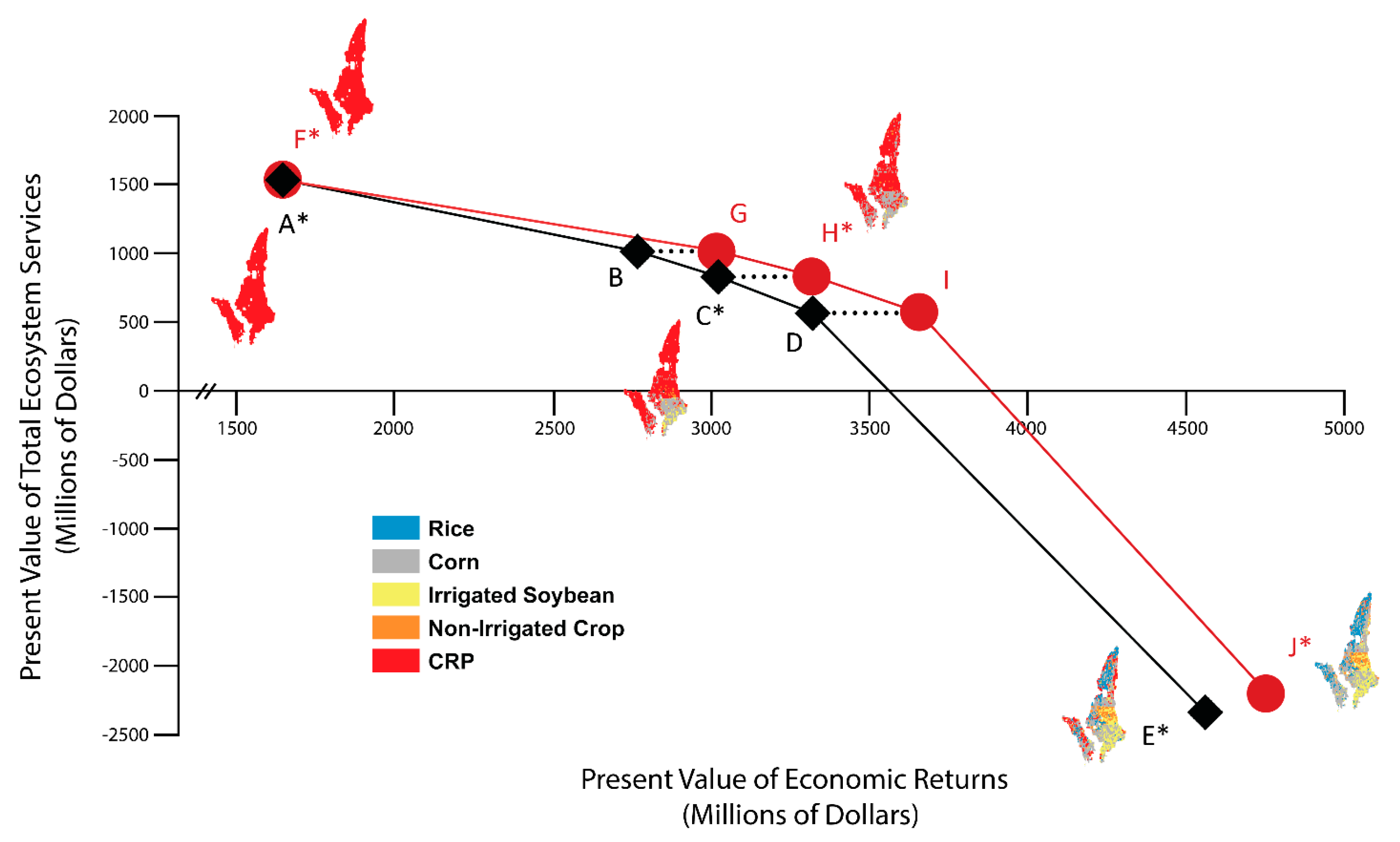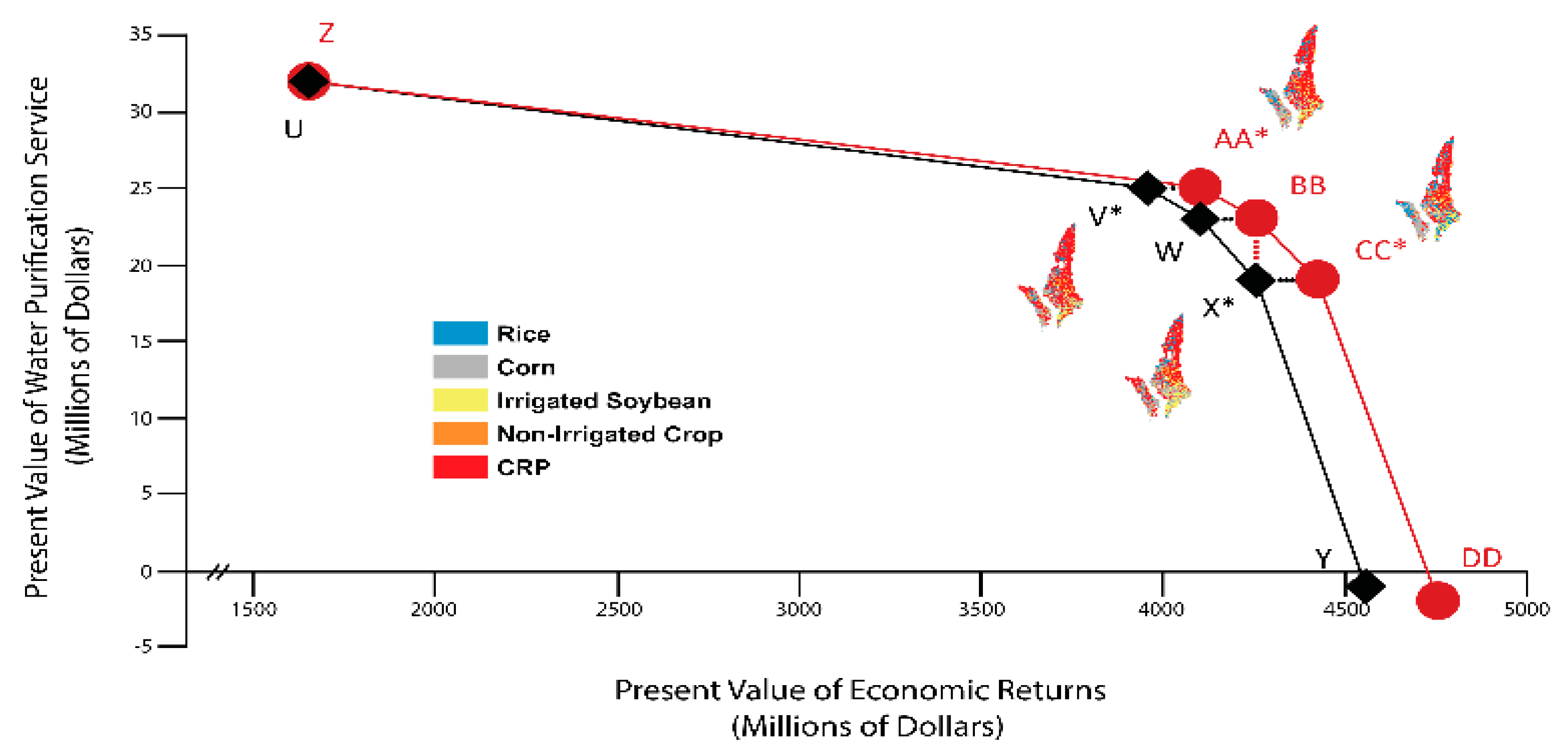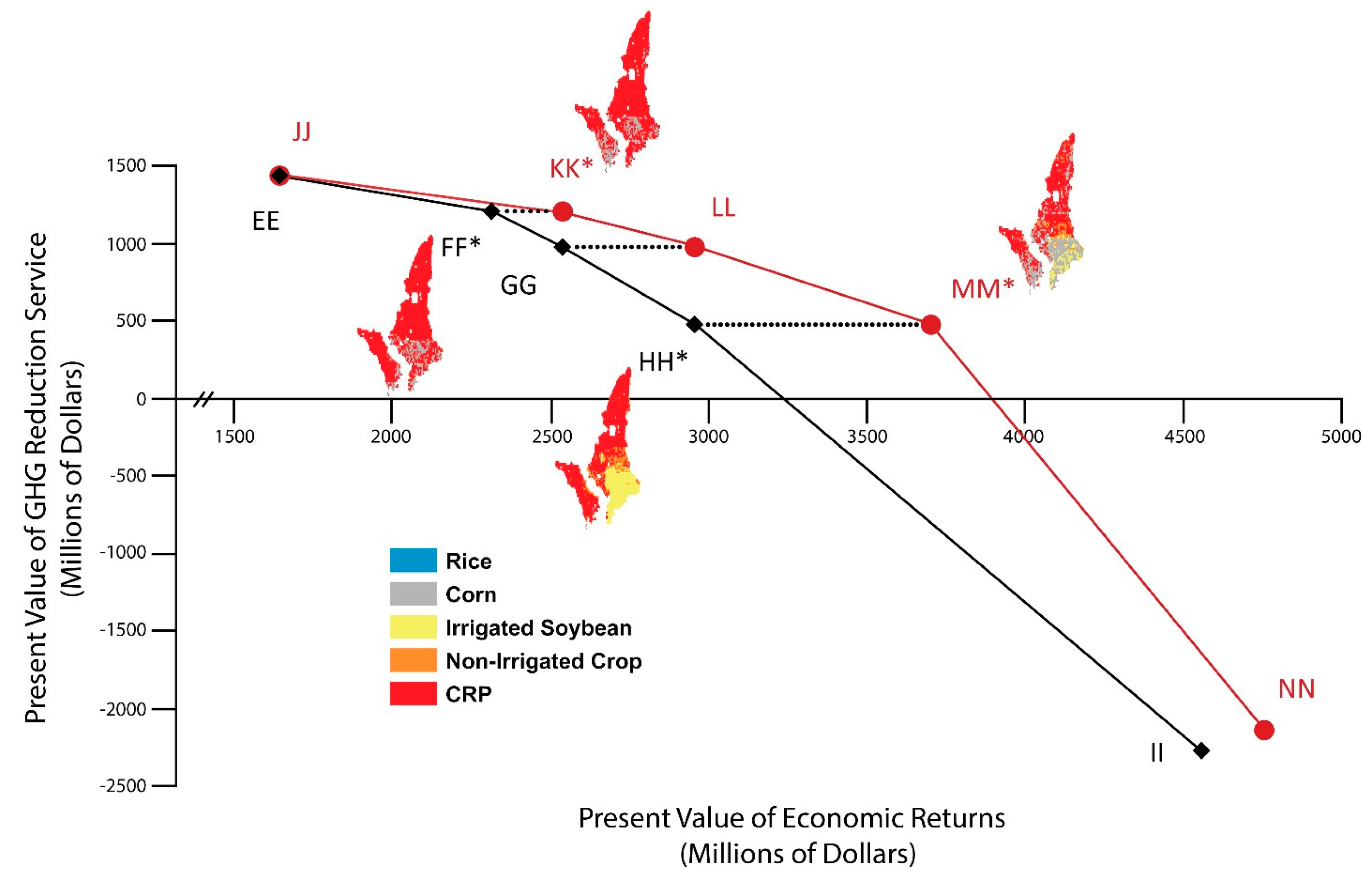The land cover of the farm landscape includes crops, reservoirs, and conserved land set aside through a rental program of the government. The chosen crops generate economic returns, but irrigation depletes groundwater. Also, agricultural runoff pollutes surface water, and farm production activities release GHGs. The landscape is spatially heterogeneous due to differences in long term investment in farm practices, soil types, and access to water resources. A time horizon T is chosen for a single generation of farmers to observe how depletion of the aquifer influences production decision, and a grid of m cells (sites) represents spatial differences.
The major crops include irrigated rice, soybean, corn, and cotton, non-irrigated sorghum and soybean, and double cropped irrigated soybean with winter wheat. There are n possible land cover types j at the end of period t as denoted by Lijt for site i that include each of the crops, reservoirs that have tail-water recovery, and the US Department of Agriculture’s Conservation Reserve Program (CRP). At the end of each annual period t, we assume any other land cover j can become on-farm reservoirs and tail-water recovery or CRP, and after a ten-year period CRP can transition into a crop. A profit maximizing farmers may switch land out of irrigated crops into non-irrigated crops with declining groundwater availability at the end of each period.
2.1. The Economic Model
The net present value of the agricultural production over all time periods and the entire landscape is the economic objective. The average annual irrigation that crop j receives to supplement precipitation, wdj, is the demand for irrigation in acre-feet. The groundwater stored in the aquifer beneath site i at the end of the period t is AQit. The water that comes from the on-farm reservoirs is RWit, and the water from well-pumping is GWit. There is recharge of the groundwater, nri, that occurs naturally from precipitation, streams, and underlying aquifers each period.
Equation (2) shows the acre-feet of water stored in an acre reservoir as
which includes,
, as the acres in reservoirs at time
t, and the total acreage at site
i,
[
7]. If the reservoir occupies the entire site
i and only the rainfall fills the reservoir, then the low-end acre-feet of water that fills each reservoir acres is
. If the reservoir is less than the size of the site, then recovery of the runoff and rainfall fills the reservoir to a high-end capacity in acre-feet per reservoir acre of
. We do not account for annual variability in the evaporation, leakage, and the timing of rainfall within a growing season, which could influence
and
for the reservoir. The use of reservoirs and tail-water recovery systems reduces water that reaches streams, and this limits the water available to downstream users and the environment during the growing season. However, most of the water used from the reservoirs is collected in the rainy season before planting.
The intensity of well-pumping across the landscape influences the way in which aquifer depletion varies over space. The proportion of the underground flow into the aquifer at site
k and out of site
i when an acre-foot is pumped from a well at site
k is
pik, which depends on the distance and the lateral speed of underground water movement based on the soil profiles observed between sites [
2]. This means the groundwater that leaves site
i is
. We assume pumps have the same efficiency and power units to deliver a fixed amount of water per minute.
The water used for irrigation must be less than the water available from reservoirs and wells (Equation (3)), and Equation (4) indicates that the water stored in the reservoirs must be greater the water used from the reservoirs. The aquifer volume in the previous period less the spatially weighted proportion of water pumped from the surrounding sites plus natural recharge equals the current aquifer volume (Equation (5)). The cost of pumping groundwater at a site,
GCit, depends on the cost to lift an acre-foot of water by one foot,
cp, and the initial depth to the groundwater,
dpi. The depletion of the aquifer volume,
, divided by the area of the site,
, shows how much the depth to the aquifer increases. Capital costs per acre-foot for the well, which accounts for new well-drilling in response to aquifer decline, is
cc (Equation (6)).
The cost to produce an acre of the crop excluding the irrigations costs caj and the price per conventional unit of the crop is prj are constant in real terms. We assume no productivity growth trend for the constant yield of crop j per acre at site i, yij. Excluding the costs of irrigation, the net value for crop j is then prjyij − caj per acre. The CRP payment per acre to the landowner, prcrpyicrp, with yield normalized to one and price is the payment per acre, less the cost to establish and maintain an acre of CRP (cacrp) is net value per acre of CRP. The reservoir pumping cost per acre-foot is crw, and the per acre capital and maintenance cost of a reservoir each period is cr. We make values over time comparable in monetary terms using the real discount factor, .
Equation (7) indicates the economic objective to maximize the present value of farm profits over the fixed horizon
T by changing the amount of land in each crop or CRP, the reservoir water use, and groundwater use, namely
Lijt, RWit, and
GWit. The initial condition of the state variables and the non-negativity constraints on land, water use, and the aquifer are shown in Equations (8) and (9).
Subject to:
and the spatial dynamics of land and irrigation (Equations (1)–(6)). The crop and irrigation choices from the optimization of Equation (7) influence ecosystem services related to GHGs, water purification, and groundwater availability, but they are not directly considered by producers.
2.2. The Ecosystem Service Model
We track changes in the physical ecosystem services over time and use estimates of non-market values taken from the scientific literature to determine the monetary value of the changes in ecosystem services to calculate the net present value of ecosystem services from the landscape.
GHG emissions per acre of vegetation on a land cover are associated with the production of crops and CRP for the major production practices of the Arkansas Delta based on a life cycle assessment (LCA) up to the farm gate [
16]. Fuel use and emissions generated during the manufacture of chemicals and fertilizer, methane emissions from rice production, and nitrous oxide emissions from the application of nitrogen fertilizer to soil are tracked in carbon equivalents (CE) in kg per acre for land cover
j (
). Pumping ground and reservoir water releases fuel combustion emissions, and the range of irrigation emissions is shown in
Figure S1. The depth of the well multiplied by a conversion factor
that identifies the carbon emitted from fuel combustion to lift an acre-foot of water one foot and multiplied by the acre-feet of groundwater pumped indicate the emissions from groundwater pumping at site
i,
. The acre-feet of reservoir water pumped multiplied by a conversion factor
for the carbon emitted from fuel combustion to pump an acre-foot of water into a reservoir and back out to the field is the emissions from pumping reservoir water at site
i,
. The total carbon emissions for time
t at site
i (
) is shown in Equation (10) as
Aboveground biomass (
) and belowground biomass (
) sequester carbon, with the parameter values in the
Supplementary Materials, and this sequestration depends on the soil texture and tillage practices [
17]. A weighting of soil textures at each site
i determines the soil factor,
, which is the fraction of carbon lost to respiration due to soil related microbial activity. Porous soil (i.e., sandy) has more intense wetting and drying cycles, and this encourages microbial activity and respiration compared to finer textured soils (i.e., clay). Equation (11) tracks the carbon sequestration,
, for time
t at site
i as
Although the sequestration is likely to be greater initially and slower later on CRP land, we suppose sequestration occurs evenly over time [
18]. Equations (10) and (11) constrain the ecosystem services objective but do not influence the economic returns objective.
The cost to society incurred by the predicted damages from each additional ton of carbon equivalent emitted to the atmosphere is the social cost of carbon,
, and this indicates the monetary value of a ton less of carbon equivalent GHGs from the agricultural landscape [
19]. Equation (12) says the value of avoided damages,
, is negative if the emissions outweigh sequestration (Equation (12)).
We use the InVEST (Integrated Valuation of Ecosystem Services and Tradeoffs) water purification model to estimate how sediment, phosphorus, and nitrogen runoff responds to land cover transitions [
20]. Natural land, urban areas, public land, and lakes are in the water purification model, although not part of the land cover in the optimization model, because they affect the agricultural runoff from each site that reaches streams. Based on soil characteristics, precipitation, slope, and evapotranspiration, the expected annual water yield at each site is calculated. The expected pollutant loading and the filtering capacities for each land cover is combined with the water yield to calculate the pollutants from each site that eventually reach a stream. The initial land cover determines pollutant
k export per acre from land cover
j for farm site
i reaching a stream,
. We assume pollutant exports from site
i are associated only with the land cover changes at site
i but not the land cover changes at surrounding sites. Tail-water recovery systems with reservoirs capture runoff, and the slope at site
i affects the effectiveness of the system. The tail-water recovery system effectiveness,
, is greater if site
i is flatter [
21].
Equation (13) indicates the amount of pollutant
k reaching the mouth of a watershed from each site
i at time
t (
) as
where
is the export without reservoirs of the pollutant
k to a stream from site
i and land cover
j [
7]. A site with reservoirs has a value less than one for
because there is land in
, and this reduces the export of pollutants to streams.
The willingness to pay (WTP) per household for a water purification improvement (
) depends on the baseline water quality and median household income of the basin
b. The WTP values per household are prorated to the percent reduction in the pollutant
k loading from all sites
i in basin
b,
. We use
because a fall in pollutant exports corresponds to an increase in water purification value. Multiplying the number of households in the basin (
) by the prorated WTP per household for pollutant
k is the present value of the surface water purification,
, shown as Equation (14)
We consider only the groundwater value to agricultural producers to buffer against periodic shortages in surface water supplies,
, because there is inadequate data to estimate the damages from subsidence and losses to in-stream flows. Aquifer volume falls if the natural recharge of the aquifer is less than the groundwater withdrawal for irrigation. Equation (15) indicates the present value of the groundwater buffer value,
, as
The sum of the present value of GHG reduction, surface water purification, and groundwater buffer value is the ecosystem services objective (Equation (16)). The objective is to maximize the present value of ecosystem services by determining
Lijt,
RWit, and
GWit over the fixed time horizon
T
subject to the Equations (1)–(6), (10), (11) and (13). The crop and irrigation choices from the optimization of Equation (16) influence farm profits but they are not directly considered by planners.
2.3. Efficiency Frontier
We trace out an efficiency frontier, showing the tradeoff of non-market ecosystem service value and market economic returns, by finding the maximum economic returns for a fixed value of an ecosystem service, and then varying the fixed non-market value of the ecosystem service over its entire potential range [
13,
14]. We compare how the reservoirs affect the shape and position of the efficiency frontier by finding efficiency frontiers without and with reservoirs. The efficiency frontier illustrates the greatest market return and non-market values feasible on the landscape and the necessary reduction in non-market value to increase market returns from the landscape.
By optimizing the non-market ecosystem service benefit objective without a restriction on market returns, the maximum non-market value of the ecosystem services is found. Conversely, by optimizing market returns without restriction on the ecosystem service value, the minimum non-market value of the ecosystem services is found. Next, ecosystem service values are chosen that extend for the range of minimum and the maximum ecosystem service values to trace out the shape of the frontier. Lastly, for each level of ecosystem service value from the previous step, we maximize market returns. A combination that rests on the efficiency frontier is a market returns maximum that corresponds to a given non-market ecosystem service value.
Non-market ecosystem service benefits for the efficiency frontier with reservoirs are chosen because they match the non-market ecosystem service values chosen for the efficiency frontier without reservoirs. A determination of the gains from moving to an outer frontier is possible by using the same non-market ecosystem service values across frontiers. We trace out the rest of the frontier with reservoirs by choosing evenly spaced ecosystem service values. We use the non-linear programming solver CONOPT from AKRI Consulting and Development to perform the optimization in the Generalized Algebraic Modeling System (GAMS) [
22].












